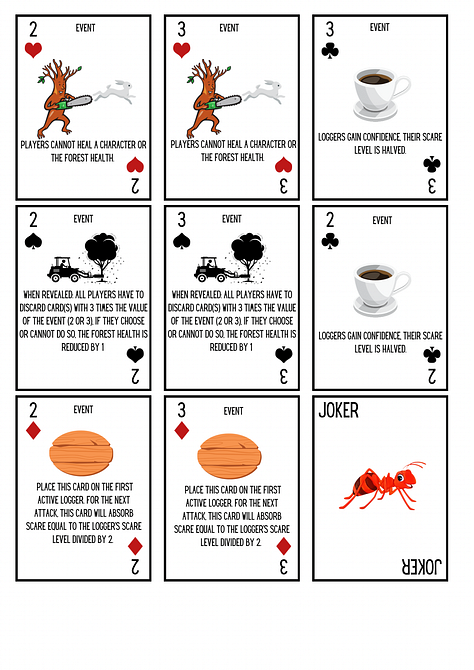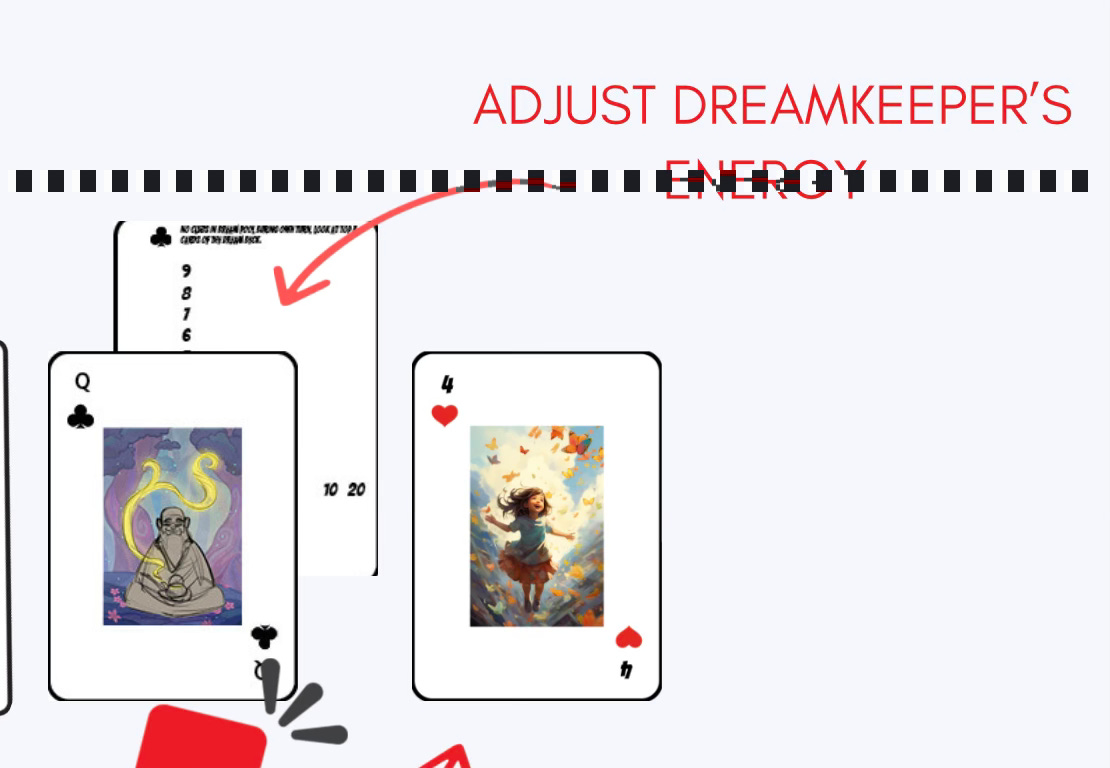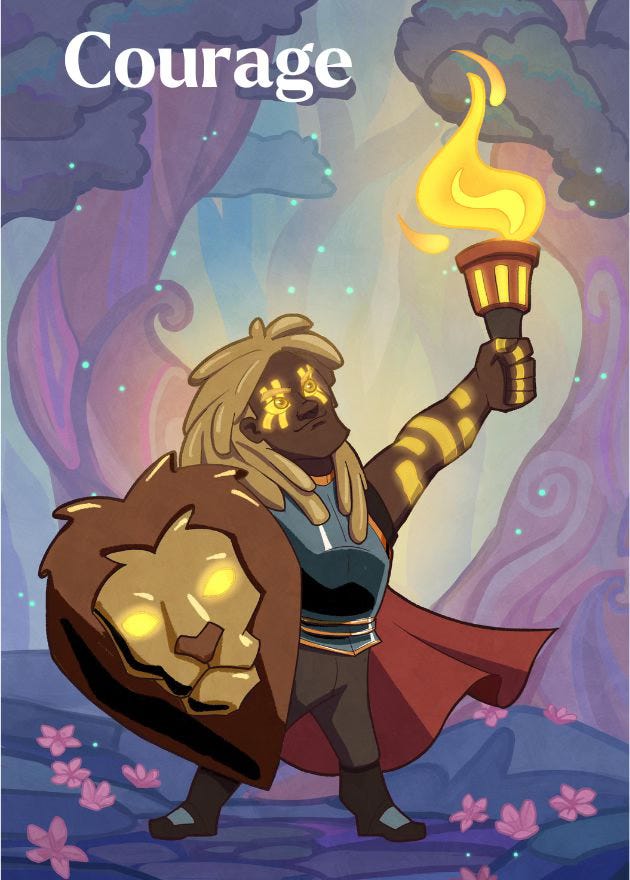Why read this?
This post is all about taking you through the game design journey with me. I’m a big fan of peeking behind the curtain to see how games are made and marketed, from idea to shelf, and I’ve soaked up plenty from other peoples’ experiences. I’ll break down the whole process of turning a blank slate into a card game, sharing my thoughts, choices, and hurdles along the way. The game’s not out yet, but I’m making good progress. I’m hoping this can be a learning spot for other designers and maybe even spark some inspiration.
Basic info on the game
Player Count: 1-4
Play time: 30 min
Age: 10+
Components: a standard 52 playing card deck
Mechanics: Deck Building, Dungeon Crawling, Cooperation
Rules (updated 2 March 2024): Dreamkeepers rules
Online version – 2 players – open hands: Two Players
Online version – solo: Solo game
Inspiration: traditional deck of cards
In July 2023, I came across the card game Regicide through the Board Game Design Lab podcast. Created by Badgers from Mars, Regicide is unique because you can play it with just a standard deck of cards, yet it’s a published, monetisable game. Its concept is incredibly elegant: it’s accessible to everyone globally, but you also have the option to buy the game if you want the beautiful custom artwork and booklet. I am convinced that games should be accessible to anyone, anywhere. This idea was the initial inspiration to create a completely different game, but with a similar ethos.
One of the additional benefits I saw in the constraints of having to use a traditional deck of cards, is that it could fuel creativity.
Design Goals
I’ve been a card game enthusiast since a very young age, playing Canasta, Klaverjas, Pokémon Trading Card Game and Magic: the Gathering. More recently, I have enjoyed a lot of games of Harry Potter: Hogwarts Battle and Legendary: A Marvel Deck Building Game. I really liked the cooperative gameplay and the accessibility of both games. These experiences made me want to design a game that’s accessible yet engaging for both casual and avid gamers. I’m drawn to deck builders and aimed to create one that emphasises teamwork and interaction, inspired by the dynamics in games I’ve co-created like our first (and only) game, Monsters of Loch Lomond.
The goal is to create a strong sense of team spirit, where quick, impactful decisions are crucial for victory, driving up the tension and urgency found in games like Hogwarts Battle or Pandemic. Every move should matter, intensifying the cooperative experience.
Game Mechanics
I figured that adding a ‘Dungeon’ crawler mechanic to the game could create this sense of urgency. So I ended up with the following mechanics: Deck Building, Dungeon Crawling, Cooperation.
Theme
I originally chose ‘Guardians of the Green’ as my theme, where players play as forest animals protecting the forest against loggers trying to cut down the forest. I still think it’s a cool and relevant theme, but after some research found it didn’t hit the mark on uniqueness. There are a gazillion animal-themed games, and if I want my game to stand out of the crowd, this was not going to be it. The first variations of the game were made with this theme in mind.
Then, somehow, I landed on ‘Dreamkeepers’. In this theme, players become Dreamkeepers, embodying virtues that protect the joyful dreams of Dreamland. Shadowmancers lurk in the dream, eager to shroud the realm in nightmares. They face off against Shadowmancers, sinister entities aiming to fill the realm with nightmares. The game takes players on an adventure through Dreamland to find Inspirations that can banish these dark forces, challenging them to keep the dream from turning into a nightmare.
Iterations and Playtesting
First version – somewhere in July or August 2023
Concept: This was still in the Guardians of the Green style. Each player was playing as an animal and they had to walk through the forest to find items which they could use to scare away the Loggers. Each player and Logger had a starting health, and there was a Forest, which also had a starting health. Players would start with low cards. The Jacks and Kings were Loggers, 2s and 3s were Events, and the rest of the cards were Inspiration cards. All were shuffled and formed a Deck. The top three cards were opened up. A player could choose a card to add to their deck, and a new card would be opened. If this card was an event, you would resolve it; if it were a Logger, you had to deal with their attack. After this, you could play two actions (actions include: heal a player, heal the forest, equip cards for an attack, attack). Then the turn ended. Players would win after they won against all Loggers; they would lose if any player’s health or the forest health reached zero, or if the deck was out of cards.
I played it a bunch of times with friends, and everybody seemed to have fun. At this point I identified three main issues:
- It was brutal: the game was incredibly difficult to win
- It felt a bit chaotic, and therefore players had trouble with following the right steps in their turns, and didn’t always make smart decisions.
- In an attempt to stimulate interactivity, I had the ♦️ cards allow players to exchange cards with other players, but players never did this in practice.
Impression of some of the cards:

September 2023
To make the ♦️ cards more useful, I changed their action to become more of a combo-card. You could play them alongside cards from other suits to boost attacks.
Playtests showed:
- It was still brutal: the game was incredibly difficult to win
- It still felt chaotic, and there was no good way to keep track of the health of each Logger and Animal. This was crucial for decision-making.
- The ♦️ combo-ability was working very well, but adding complexity.
- In a deckbuilder you want your deck to become stronger, so you might want to thrash weaker cards, this was missing now.
October 2023
I entered the ‘Traditional Deck Game Design Contest’ on BoardGameGeek. And I revamped the theme to Dreamkeepers. Animals became Dreamkeepers (virtues), and Loggers became Shadowmancers.
How I tried to make the game less brutal
- The ♦️ cards could be a bit stronger, so I allowed them to be combined with other actions (healing players, healing “the Dream” (previously the forest), and blocking).
- To make the game less brutal, I removed the lose-condition “when the deck is out of cards”.
- Added an action to thrash cards from a player’s own deck.
- I added Jokers which could prevent all damage for one turn.
How I tried to make it more clear and intuitive
- I changed the drawing phase to run through cards quicker and in a more logical way
- I tested out various ways to keep track of health scores with only cards, pen and paper. I hadn’t found the right way.
- I aligned the special abilities of Dreamkeepers with the actions of the cards in their respective suits to make it more intuitive.
One of the ways to keep track of health

Findings:
- Still brutal, but a little less so.
- It still felt a bit chaotic and there was still no good way to keep track of the health of each Dreamkeeper and Shadowmancer.
- Diamonds were working pretty well.
- People were still having fun.
November 2023
I really tried a lot of things this month. It was the last month of the Game Design Contest, so I was determined to make it count. Despite my efforts, I didn’t succeed. I experimented with rebalancing health levels, attack strengths, the number of Shadowmancers, increasing the card hand limit, adding more actions, devising various scoring methods, and ways for players to exchange cards, among other things. The main issue was that the game still felt too chaotic, making it hard to strategize and win.
I paused development for a while to let the Game Design Contest conclude and to gather feedback from the BGG forum. The feedback I received was incredibly helpful! Ultimately, the game ranked 5th overall and won 2nd place for best theme, which was quite an achievement considering its state at the time.
Impression of the cards at this point

January-March 2024
During this time, I didn’t play much with other players and mostly iterated myself. I wanted to get the chaos out, and have a very elegant manner in keeping scores. So I had to go back to the basics, make it simple and go from there.
In this time I revamped the game completely. Main changes include:
- Shadowmancers having their own Shadowmancer deck (♣️)
- Only 4 Shadowmancers (only the Kings)
- Adjusted the Dreamkeepers abilities
- Rebalanced the Dreamkeepers’ starting Energy
- Rewritten the Inspirations (the actions of ♦️, ♥️ and ♠️)
In my own findings, the game plays much smoother now. The player sequence is clearer, and I found a way to keep track of all the Dreamkeepers’ and Shadowmancers’ health without using pen and paper, whilst still being visible at all times to all players.
Current version: This is the current version of the game, and the rules can be found here: Rules.
Continue playtesting: I will be testing this further in the coming days/weeks and will post my findings when I have more to tell.
Artwork
The goal is to actually publish the game, so I really want to have the coolest artwork ever. I am working with the talented artist Rixt Heerschop now who is making the illustrations and card designs.
A sneak peek of the first Dreamkeeper, Courage:

Feedback
You can already play the game right now with a normal deck of cards, or you can play it online: Two Players (open hands), Solo game.
Any feedback you have on either the game, or the art, is much appreciated! Email me at robin@foursuitstudio.com.
